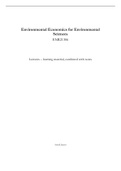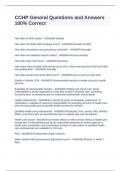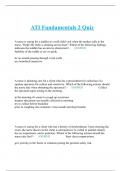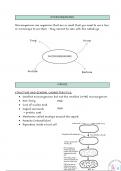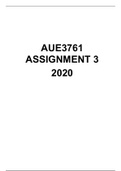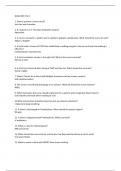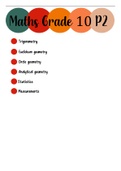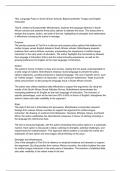Sciences
ENR21306
Lectures – learning material, combined with notes
Anneli Janzer
,Content
Lecture 1 – Foundations of Environmental Economics ..................................................................................... 1
1. What economics is and is not? ................................................................................................................... 1
2. Scarcity ....................................................................................................................................................... 2
2.1 Alternative uses for scarce resources .................................................................................................... 2
2.1.2 Efficiency and Optimality ....................................................................................................................... 2
3. Summary of Lecture 1 ................................................................................................................................ 3
Lecture 2 – Introduction Microeconomics ........................................................................................................ 4
1. Link between the environment and human action .................................................................................... 4
2. Environmental growth and environmental pollution ................................................................................. 4
3. Introduction to microeconomic theory ....................................................................................................... 6
4. Refresher of mathematic calculus .............................................................................................................. 8
5. Summary of Lecture 2 ................................................................................................................................ 9
Lecture 3 - Principles of consumer choice and utility maximization ................................................................ 10
1. Principles of consumer choice .................................................................................................................. 10
2. The indifference curve .............................................................................................................................. 10
2.1 Key properties of the indifference curve .............................................................................................. 11
3. Utility maximization with a budget constraint......................................................................................... 12
3.1 The Marginal Rate of Substitution (MRS) ............................................................................................ 13
3.2 Utility optimization ..................................................................................................................................... 14
3.3 The Lagrange method in seven steps .......................................................................................................... 15
3.3.1 Interpretation of the Lagrange multiplier λ ......................................................................................... 16
3.4 Impact of changes in income or prices ................................................................................................ 17
4 Summary of Lecture 3 .............................................................................................................................. 17
Lecture 4 - Principles of producer behaviour + Efficient resource allocation on a competitive market I ......... 18
1. Principles of Producer Behaviour ............................................................................................................. 18
2. Optimal combination of inputs ................................................................................................................ 19
2.1 Key question 1...................................................................................................................................... 20
2.2 Key question 2...................................................................................................................................... 20
2.3 Key question 3...................................................................................................................................... 21
3. Efficient allocation in a competitive market ............................................................................................ 22
4. Summary Lecture 2-4 ............................................................................................................................... 24
Lecture 5 - Efficient resource allocation on a competitive market II + Market failure as a cause of a
misallocation of natural resources I ............................................................................................................... 25
1. Welfare analysis of competitive market equilibrium ............................................................................... 25
1.1 A class room experiment ..................................................................................................................... 25
, 2. Market failure .......................................................................................................................................... 26
2.1 Consequences of market failure .......................................................................................................... 28
2.2 Welfare implications of market failure ................................................................................................ 28
3. Short summary and highlights of the previous lecture(s) ........................................................................ 31
Lecture 6 – Market failure as a cause of misallocation of natural resources II + Pollution control ................. 32
1. Efficient supply of a public good .............................................................................................................. 32
2. The economics of pollution ...................................................................................................................... 33
3.1 Flow pollution (emissions and damages) ............................................................................................. 33
3.2 Stock pollution (emissions and damages) ............................................................................................ 34
3.3 The private and the social perspective ................................................................................................ 35
Lecture 7 – Pollution control .......................................................................................................................... 36
1. Determining the “optimal pollution level” ............................................................................................... 36
2.3 Modeling the private and the social optimum – an illustrative example ............................................ 37
1.2 (Net) benefit functions of pollution...................................................................................................... 38
1.3 Privately and social socially efficient level of pollution ........................................................................ 39
4 Discounting .............................................................................................................................................. 40
2.1 Discounting of Benefits ........................................................................................................................ 40
2.2 Discounting of costs ............................................................................................................................. 41
2.3 Discounting utility - approaches .......................................................................................................... 42
2.3.1 Exponential discounting....................................................................................................................... 42
2.3.2 Gamma or hyperbolic disounting ........................................................................................................ 42
2.4 Why discount utility? ........................................................................................................................... 42
2.5 Discounting in the climate change discourse ....................................................................................... 43
Lecture 8 – Environmental pollution control: targets ..................................................................................... 45
1. Optimal Pollution consumption 1 ............................................................................................................. 45
2. Optimal Pollution example 2 .................................................................................................................... 45
3. Mechanisms for correcting market failure ............................................................................................... 46
3.1 Criteria for selection of instruments .................................................................................................... 46
3.2 Command and control instruments (CAC) ........................................................................................... 46
3.2.1 Examples: ............................................................................................................................................. 46
3.2.2 Caveats ................................................................................................................................................ 46
3.2.3 CAC generally not cost-effective .......................................................................................................... 46
3.3 Cost-effectiveness (cost-efficiency) ...................................................................................................... 47
3.4 Economic instruments ......................................................................................................................... 47
4. Efficient emission reduction (abatement) ................................................................................................ 47
4.1 Calculation Example ............................................................................................................................ 48
, 4.1.1 Cost-effectiveness ................................................................................................................................ 49
4.1.2 Tradable Permits.................................................................................................................................. 49
4.2 Cap and Trade ...................................................................................................................................... 50
4.3 Flexible permits with offset .................................................................................................................. 50
Lecture 9 – Pollution control – Instruments I .................................................................................................. 51
1. Socially-efficient emission targets and tax ............................................................................................... 51
2. Implications of emission taxes ................................................................................................................. 52
2.1 Example ............................................................................................................................................... 52
Lecture 10 - Pollution instruments: Institutional Instruments ........................................................................ 54
1. Coase theorem ......................................................................................................................................... 54
1.1 Exercise: Pub “The Doctor” .................................................................................................................. 55
2. Common property .................................................................................................................................... 55
3. Institutional approaches .......................................................................................................................... 56
4. Conclusion ................................................................................................................................................ 57
4.1 Economic instruments ......................................................................................................................... 57
4.2 Command and control instruments ..................................................................................................... 57
4.3 Institutional instruments ..................................................................................................................... 57
Lecture 11 - Pollution control: imperfect information .................................................................................... 58
1. How economists deal with different types of imperfect information ...................................................... 58
4.4 Decision-making with imperfect information ...................................................................................... 58
1.1.1 Two quick exercises ............................................................................................................................. 59
2 Price-based versus quantity-based instruments under uncertainty ......................................................... 59
2.1 Pollution control under uncertainty ..................................................................................................... 59
2.1.1 Overestimation .................................................................................................................................... 60
2.1.2 Underestimation .................................................................................................................................. 61
2.2 Uncertainty and threshold effects ....................................................................................................... 62
3. Revealing Information .............................................................................................................................. 63
Lecture 12 – International environmental problems: Game Theory ............................................................... 65
1. Game theory ............................................................................................................................................ 65
1.1 Nash equilibrium .................................................................................................................................. 66
1.2 Prisoner’s Dilemma .............................................................................................................................. 67
2. International environmental problems as games .................................................................................... 67
2.1 Assurance game................................................................................................................................... 67
2.2 Sequential dynamic games .................................................................................................................. 68
2.3 Chicken game....................................................................................................................................... 68

